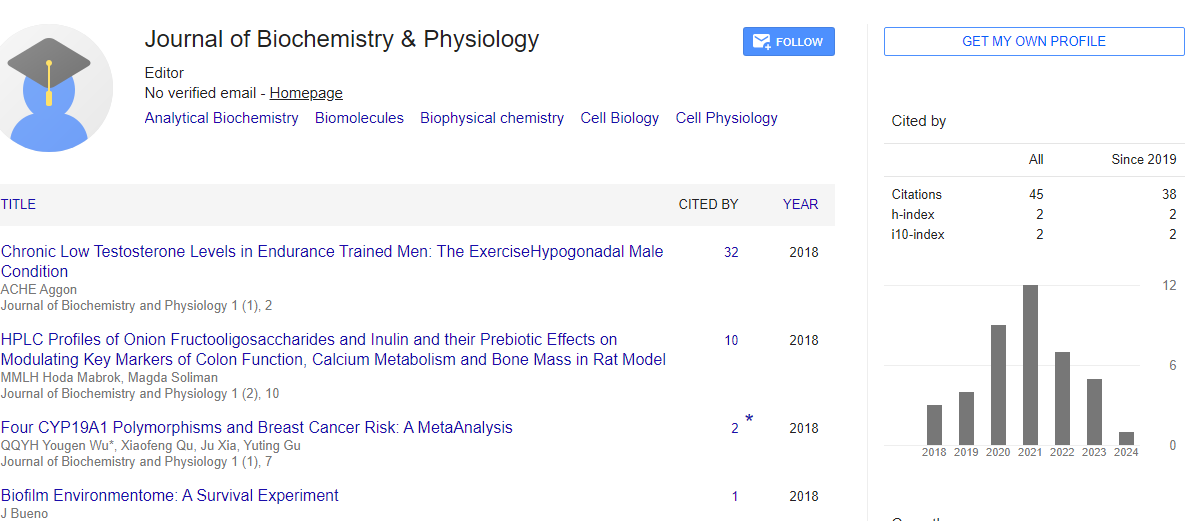Opinion Article, J Biochem Physiol Vol: 7 Issue: 1
Antimicrobial Resistance: Mechanisms, Evolution, and Therapeutic Strategies
Mabori Kile*
1Department of Veterinary Clinical Pathology, Federal University of Rio Grande do Sul, Porto Alegre, Brazil
*Corresponding Author: Mabori Kile,
Department of Veterinary Clinical Pathology,
Federal University of Rio Grande do Sul, Porto Alegre, Brazil
E-mail: kilema@bo.br
Received date: 19 February, 2024, Manuscript No. JBPY-24-134949;
Editor assigned date: 21 February, 2024, PreQC No. JBPY-24-134949 (PQ);
Reviewed date: 11 March, 2024, QC No. JBPY-24-134949;
Revised date: 20 March, 2024, Manuscript No. JBPY-24-134949 (R);
Published date: 29 March, 2024, DOI:10.4172/jbpy.1000148.
Citation: Kile M (2024) Antimicrobial Resistance: Mechanisms, Evolution, and Therapeutic Strategies. J Biochem Physiol 7:1.
Description
Antimicrobial Resistance (AMR) poses a significant global health threat, undermining the effectiveness of antimicrobial agents and complicating the treatment of infectious diseases. The emergence and spread of resistant pathogens result from complex interactions between microbial genetics, selective pressures, and human activities. This article explores the mechanisms of antimicrobial resistance, the evolutionary dynamics driving resistance emergence, and current therapeutic strategies to combat AMR.
Antimicrobial resistance can arise through various mechanisms, including genetic mutations, horizontal gene transfer, and selective pressure from antimicrobial use. Bacteria, fungi, viruses, and parasites employ diverse strategies to evade the effects of antimicrobial agents, such as antibiotics, antifungals, antivirals, and antiparasitic drugs. Common mechanisms of resistance include enzymatic degradation or modification of antimicrobial agents, alterations in drug targets or binding sites, and efflux pumps that extrude antimicrobial agents from microbial cells, reducing intracellular drug concentrations.
The evolution of antimicrobial resistance is driven by selective pressures imposed by antimicrobial agents, coupled with the intrinsic genetic variability and adaptability of microorganisms. Genetic mutations that confer resistance traits can arise spontaneously through replication errors or exposure to mutagenic agents. Horizontal gene transfer mechanisms, such as conjugation, transformation, and transduction, facilitate the spread of resistance genes between microbial species, contributing to the rapid dissemination of resistance determinants within microbial populations.
Selective pressures from antimicrobial use, including overuse, misuse, and suboptimal dosing, accelerate the emergence and spread of resistant pathogens by promoting the survival and proliferation of resistant strains. Environmental factors, such as antibiotic residues in wastewater and agricultural runoff, also contribute to the selection and dissemination of resistance genes in microbial communities, further exacerbating the AMR crisis. Addressing antimicrobial resistance requires a multifaceted approach that encompasses surveillance, stewardship, innovation, and global collaboration. Surveillance programs monitor the prevalence and distribution of resistant pathogens, antimicrobial use patterns, and resistance mechanisms, providing valuable data to guide treatment decisions and public health interventions.
Antimicrobial stewardship programs promote rational antimicrobial use practices, including appropriate prescribing, dosing, and duration of therapy, to minimize the emergence and spread of resistance. Education and awareness campaigns aimed at healthcare providers, patients, and the general public raise awareness of AMR issues and promote responsible antimicrobial use behaviors.
Innovation in antimicrobial drug discovery and development is essential for replenishing the antibiotic pipeline and overcoming resistance mechanisms. Strategies to combat AMR include the development of novel antimicrobial agents with unique mechanisms of action, combination therapy approaches that target multiple pathways, and the repurposing of existing drugs to enhance efficacy and circumvent resistance.
Other therapeutic strategies to combat AMR includes the development of alternative therapies, such as phage therapy, antimicrobial peptides, and immunotherapies, which offer potential alternatives to traditional antibiotics. Non-pharmaceutical interventions, such as infection prevention and control measures, vaccination programs, and sanitation improvements, also play crucial roles in reducing the burden of resistant infections and preventing their spread
Conclusion
Antimicrobial resistance is a complex and multifaceted problem that threatens the effectiveness of antimicrobial therapy and undermines global efforts to control infectious diseases. Addressing AMR requires a coordinated and interdisciplinary approach that encompasses surveillance, stewardship, innovation, and global collaboration. By understanding the mechanisms of resistance, the evolutionary dynamics driving resistance emergence, and implementing effective therapeutic strategies, we can mitigate the impact of AMR and preserve the efficacy of antimicrobial agents for future generations.
 Spanish
Spanish  Chinese
Chinese  Russian
Russian  German
German  French
French  Japanese
Japanese  Portuguese
Portuguese  Hindi
Hindi 